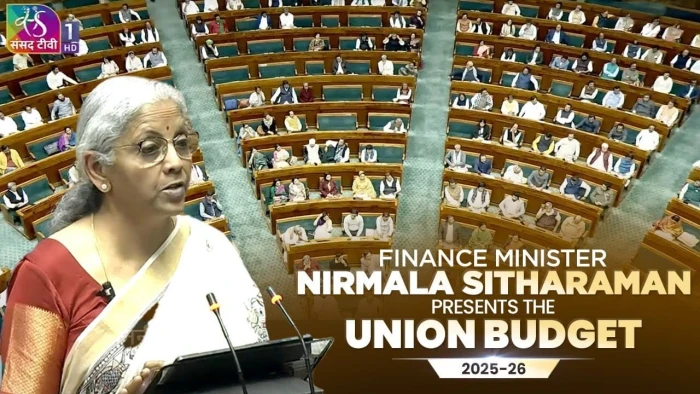Union Budget 2025-26: Key Highlights and Proposals by FM Nirmala Sitharaman



TLDR: The Union Budget 2025-26 presented by FM Nirmala Sitharaman focuses on accelerating growth, inclusive development, and enhancing the spending power of India's middle class. Key proposals include reforms in agriculture, MSMEs, investments in education and health, tax reforms aimed at the middle class, and initiatives to boost exports and manufacturing.
On February 1, 2025, Finance Minister Nirmala Sitharaman presented the Union Budget for the fiscal year 2025-26. This budget aims to accelerate growth, secure inclusive development, invigorate private sector investments, uplift household sentiments, and enhance the spending power of India's rising middle class. The overarching theme is to unlock the nation's potential for greater prosperity and global positioning under the leadership of Prime Minister Narendra Modi.
## Economic Context
As we complete the first quarter of the 21st century, global economic growth is projected to slow down. However, India remains the fastest-growing major economy, with a strong development track record over the past decade. The government sees the next five years as a unique opportunity to realize the vision of "Sabka Vikas" (development for all).
## Key Focus Areas
The budget outlines ten broad areas of development measures focusing on:
1. **Garib (the poor)**
2. **Youth**
3. **Annadata (farmers)**
4. **Nari (women)**
5. **Agricultural growth and productivity**
6. **Rural prosperity and resilience**
7. **Inclusive growth**
8. **Manufacturing and Make in India**
9. **MSMEs (Micro, Small, and Medium Enterprises)**
10. **Innovation and exports**
## Transformative Reforms Across Six Domains
The budget aims to initiate transformative reforms across six domains:
- Taxation
- Power sector
- Urban development
- Mining
- Financial sector
- Regulatory reforms
### Agriculture as the First Engine
The government will launch the **Prime Minister Dan Dan Krishi Yojana**, focusing on enhancing agricultural productivity in 100 districts with low productivity. Key initiatives include:
- Crop diversification and sustainable practices
- Augmenting post-harvest storage
- Improving irrigation facilities
- Facilitating credit availability for farmers
A comprehensive multi-sectoral rural prosperity program will also be launched to address underemployment in agriculture, focusing on rural women, young farmers, and landless families.
### MSMEs as the Second Engine
The budget emphasizes the importance of MSMEs, which employ 7.5 crore people and contribute significantly to manufacturing and exports. Key proposals include:
- Enhanced investment and turnover limits for MSMEs
- Increased credit guarantee cover
- Customized credit cards for micro-enterprises
- A new fund of funds for startups and women entrepreneurs
### Investment as the Third Engine
Investment in people, economy, and innovation is crucial. Key initiatives include:
- Nutritional support programs for children and mothers
- Establishment of 50,000 Atal Tinkering Labs in schools
- Expansion of medical education with additional seats in medical colleges
- Support for urban livelihoods and social security for gig workers
### Exports as the Fourth Engine
To boost exports, the government will set up an **Export Promotion Mission** with sectoral targets. This includes:
- Easy access to export credit
- Development of domestic manufacturing capacities
- Support for MSMEs to tackle non-tariff measures in overseas markets
## Tax Reforms
The budget proposes significant tax reforms aimed at the middle class, including:
- No income tax for individuals earning up to 12 lakh rupees
- Revised tax slabs to reduce the tax burden on middle-class taxpayers
- Rationalization of TDS and TCS provisions to ease compliance
## Fiscal Policy and Economic Outlook
The fiscal deficit is projected to be 4.8% of GDP for 2025-26, with total receipts estimated at 34.96 lakh crore rupees and total expenditure at 50.6 lakh crore rupees. The government aims to maintain a declining path for central government debt as a percentage of GDP.
## Conclusion
The Union Budget 2025-26 reflects the government's commitment to fostering inclusive growth and enhancing the economic landscape of India. With a focus on agriculture, MSMEs, investments, and tax reforms, the budget aims to empower citizens and stimulate economic activity, paving the way for a prosperous future for all.



